Chinese cuisine is beloved worldwide, and one of its most iconic dishes is the humble yet delicious 饺子 (jiǎo zi). Whether steamed, boiled, or pan-fried, these dumplings are a staple in Chinese households and restaurants. But how do you accurately translate "饺子" into English? Let’s explore the correct terminology, cultural context, and common misconceptions.

The Direct Translation: "Dumpling"
The most accurate English word for 饺子 is "dumpling." This term broadly refers to small pieces of dough wrapped around a filling, which perfectly describes 饺子. However, "dumpling" can also refer to other global varieties, such as Polish pierogi or Italian ravioli. To specify Chinese-style dumplings, you might say:
- Chinese dumplings
- Jiaozi (using the pinyin spelling)
Using "jiaozi" helps distinguish it from other dumpling types, especially in food discussions where precision matters.
Regional Variations and Names
Different English-speaking regions may use varying terms:

- UK/Australia: Often just "dumplings," but context clarifies.
- North America: "Potstickers" (for 煎饺, pan-fried dumplings).
Note: "Potstickers" technically refer to 煎饺 (jiān jiǎo), a specific type of 饺子 with a crispy bottom. Calling all 饺子 "potstickers" is incorrect.
Why "Dumpling" Isn’t Always Enough
While "dumpling" works, it lacks cultural specificity. For example:
- Gyoza (Japanese) vs. Jiaozi (Chinese): Though similar, gyoza usually have thinner wrappers and a garlicky filling.
- Pierogi (Eastern European): Made with different dough and fillings like potato or cheese.
If writing for an international audience, adding "Chinese" or "jiaozi" avoids confusion.

Common Mistakes to Avoid
- Calling Them "Dim Sum": Dim sum (点心) refers to a variety of Cantonese small dishes, not just dumplings.
- Using "Wonton" Interchangeably: Wontons (馄饨) are a separate dish with thinner wrappers, usually served in broth.
- Overusing "Potsticker": Reserve this for pan-fried 煎饺 only.
How to Use the Term in Sentences
- Correct: "We ate jiaozi for Lunar New Year."
- Correct: "She makes the best Chinese dumplings."
- Incorrect: "I love dim sum dumplings." (Unless referring to a dim sum menu item.)
Cultural Significance of Jiaozi
饺子 aren’t just food—they’re tied to traditions. During Chinese New Year, families gather to make dumplings, symbolizing wealth and unity. The shape resembles ancient silver ingots, representing prosperity. Knowing this context enriches the term’s meaning beyond translation.
When to Use "Jiaozi" vs. "Dumpling"
- Use "jiaozi" in food blogs, cultural articles, or menus to emphasize authenticity.
- Use "dumpling" for general audiences unfamiliar with Chinese terms.
Expert Tip: Phonetic Spelling Matters
If writing "jiaozi," include the pinyin (jiǎo zi) to aid pronunciation. Avoid outdated spellings like "gyoza" (Japanese) or "jiao-tze."
Conclusion
The best translation for 饺子 is "Chinese dumpling" or "jiaozi," depending on context. While "dumpling" suffices, adding cultural nuances ensures clarity and respect for the dish’s origins. Next time you see 饺子 on a menu, you’ll know exactly what to call it—and why it matters.

Understanding food terminology bridges cultures. Whether you’re a traveler, foodie, or language learner, getting the name right is the first step to appreciating the dish fully. Now, go enjoy some freshly steamed jiaozi—and impress others with your knowledge.



